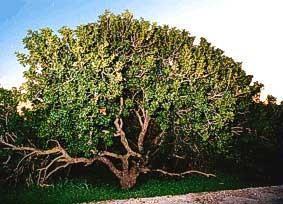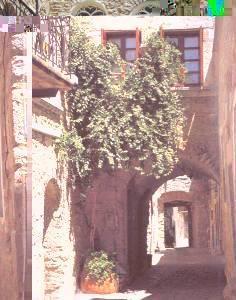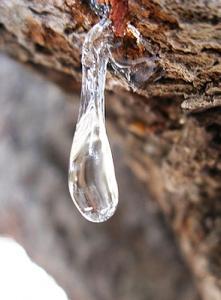Chios Mastic Products: Just name it...
Products made of Chios Mastic Gum include: In medicine, pharmaceutical products like medical creams, dental tooth paste, cures for ulcer. In the paint industry, cosmetics, paint varnish, artist's oil colors. In the food industry, liquors, ice cream, pure mastic gum, chewing gum and, probably the most precious of all, mastic oil.
 When you masticate the crystal-like yellowish resin, you get a snow-white, very durable and pliable bit of chewing gum that will last for a long time without disintegrating. It is not unlike the spruce and pine gum traditionally chewed in Canada and the U.S. (Lentisk Bush photo to the right.)
Mastic resin is found in varnishes. The lentisk berries can be crushed to obtain an oil which is used in a liquor, or they can be used whole to flavour sausages.
The plant leaves and stems are burned to smoke meats. Masticha is often prepared in a liquid form, mixed with honey or sugar, and spooned into cold water (col. called Hypovrihio=submarine) as the main flavor for a refreshing drink.
Researchers at the Nottingham University Hospital and Barnet General Hospital have confirmed what was a centuries-old firm belief, namely that Chios mastic is an effective treatment for ulcers. The findings showed that, even in small doses of one gram a day for two weeks, mastic gum could cure peptic ulcers.
Gum mastic is widely used in the preparation of ointments for skin afflictions like burns and eczema, frostbite, and cancers, including the manufacture of plasters. Natural gum mastic from Chios has been proven to absorb cholesterol, thus diminishing chances of heart attacks and high blood pressure, and helps reduce triglycerides and total lipid levels of the organism. Gum mastic is excellent for oral hygiene, and as an antiseptic for the mouth. That is why many toothpastes and mouthwashes have mastic as their main ingredient.
In Greece, Chios gum mastic is widely used in the production of many alcoholic drinks, especially liqueurs and ouzo. The liqueur "Chios Masticha" and the drink "Masticha Ouzo" are well-known Greek drinks. The Arabs flavor their drinking water by burning gum mastic. Chios gum mastic is used in sweets, candies, Turkish delight or "loukoumia," biscuits, ice cream, buns and crackers. It is also used to flavor other food. The " Masticha Sweet," which is well known, is served in a peculiar way and is called "Submarine," since it is submerged in a glass of water.
 Chios gum mastic is also used as a spice. In Cyprus and Saudi Arabia, as well as in all Arab countries, mastic is considered the most essential spice. In Cyprus, they even flavor bread with gum mastic. In Lebanon and Syria, the housewives make a kind of traditional cheese that smells and tastes of mastic. The Arabs consider it a great luxury to flavor their food, sweets, or even their milk, with gum mastic, a fact which can be attributed to reference made in their sacred books.
Masticha is an important ingredient in Greek festival breads. At New Year's, a traditional bread called Vasilopitta, or St. Basil's Bread, is prepared. Traditionally, Vasilopitta is not cut until New Year's Eve, but a twisted loaf, called Tsoureki, is made from pretty much the same ingredients and it is produced year round. In Greece, depending upon your village creed, Tsoureki might be eaten only at Easter; however, it is common to see it in Greek bakeries, wherever Greek communities live, at any time of the year. This is a bread to eat with strong tea or coffee and maybe a little thick Greek yogurt on the side. Like Jewish challah, which it resembles, slightly stale Tsoureki makes superb French toast. 
Licorice-flavored mastic, called mastiha in Greek, is perhaps the most famous indigenous Greek spice. The amber-colored mastic sap resin is tapped from the lentil bush (Pistachio lentiscus), and occurs only on the island of Chios. Although the bush has been transplanted to other tropical areas of the world, it will not produce the liquid that hardens into the mastic sap teardrops. This phenomenon has been the subject of much research.
Mastic resin is exported throughout the world for confectionery, distillery, and pharmaceutical purposes. In Greek cuisine, masticha is used in cakes, cookies, drinks, liqueurs, and candies. In the summertime, Greeks enjoy a masticha drink called souma or soumatha. To make soumatha, a syrupy almond milk is made from pounded almonds, sugar, and masticha, which is then mixed with an equal part of water. Pure refreshment! |
|



